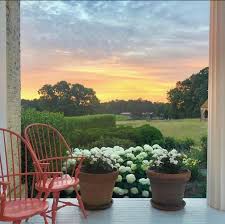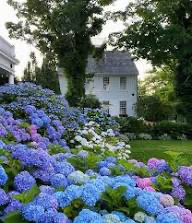My Love Affair with Hydrangeas: A Hamptons Story
- Sarah Minardi

- Apr 2, 2024
- 4 min read
In the midst of the landscape of our community, there exists a floral treasure that holds a special place in my heart: the hydrangea. These exquisite blooms, with their lush petals and captivating colors, have been a constant source of joy and inspiration in my life, adorning the landscape of my years here with timeless beauty.

My journey with hydrangeas began with a fascination for their storied history and unparalleled elegance. Originating from East Asia, these enchanting flowers found their way into the gardens of the affluent in the 18th century, captivating the hearts of botanists and horticulturists alike with their ethereal charm.
As a born and raised resident of the Hamptons, I've witnessed firsthand how hydrangeas have woven themselves into the fabric of our community, gracing the landscapes of historic mansions and exclusive retreats with their enchanting presence. Their timeless beauty serves as a reminder of the rich heritage and refined tastes that define life on the East End.
Within the realm of hydrangeas, I've cultivated a deep appreciation for the diverse array of varieties that adorn my routes of travel each day. From the classic Bigleaf hydrangeas with their show-stopping blooms in shades of blue and pink, to the delicate Lacecaps that exude understated sophistication; each variety adds its own unique charm to my garden oasis.
As I wander through the meticulously manicured grounds of the homes that I help people buy and sell, I am greeted by the majestic presence of Oakleaf hydrangeas and the graceful panicles of PeeGee hydrangeas, each contributing to the tapestry of botanical splendor that surrounds me.
Through years of dedication and passion, the landscapers and homeowners have cultivated personal sanctuaries where hydrangeas reign supreme, their vibrant colors and lush foliage serving as a constant source of inspiration and tranquility. In the Hamptons, where extravagance knows no bounds, the love affair with hydrangeas is a testament to the enduring beauty of nature's most exquisite creations.
Did you know the color of a hydrangea is primarily determined by the presence of specific pigments within the flower petals, coupled with the pH level of the soil in which the plant is grown? The two key pigments responsible for hydrangea coloration are anthocyanins and flavonoids. Anthocyanins produce hues ranging from blue to purple, while flavonoids contribute to pink and red tones. No financial investment can give you a color to match the art on your wall or your favorite shade of pink or blue. I like that about hydrangeas.
The pH level of the soil plays a crucial role in influencing the availability of these pigments to the hydrangea plant. In acidic soil with a pH below 6.0, aluminum ions are more soluble, allowing the hydrangea to absorb them and produce blue or purple flowers. Conversely, in alkaline soil with a pH above 6.0, aluminum becomes less available, leading to pink or red blooms as anthocyanin pigments are less dominant. White hydrangeas, on the other hand, lack the presence of anthocyanin pigments altogether, resulting in pure white flowers regardless of soil pH. Therefore, by manipulating the pH level of the soil, gardeners can control the color of their hydrangeas, transforming them from delicate pinks to vibrant blues or pristine whites.
It's time to start thinking about your hydrangea investment. Here are five considerations:
Location and Soil Conditions: Plant hydrangeas in a location that receives partial shade, especially in hotter climates, to prevent wilting. Ensure the soil is well-draining, rich in organic matter, and has a pH level between 5.5 and 6.5 for optimal growth and bloom color. Adjust soil pH as needed to achieve the desired flower color.
Watering: Hydrangeas have shallow root systems and require consistent moisture to thrive. Water deeply and regularly, especially during hot, dry periods, to keep the soil consistently moist but not waterlogged. Mulching around the base of the plant helps retain moisture and regulate soil temperature.
Fertilization: Apply a balanced, slow-release fertilizer formulated for flowering shrubs in spring, following package instructions. Avoid high-nitrogen fertilizers, as they can promote excessive foliage growth at the expense of flower production. Additionally, incorporate compost or organic matter into the soil annually to improve soil fertility.
Pruning: Knowing when to prune hydrangeas depends on the specific type of hydrangea and its blooming habits. For varieties that bloom on old wood (e.g., Bigleaf and Oakleaf hydrangeas), prune immediately after flowering in late summer or early fall to avoid cutting off next year's flower buds. For varieties that bloom on new wood (e.g., PeeGee and Annabelle hydrangeas), prune in late winter or early spring before new growth emerges to encourage vigorous flowering.
Protection from Frost: In the Hamptons, where late spring frosts are a concern, provide protection for emerging hydrangea buds by covering the plants with frost cloth or a layer of mulch until the risk of frost has passed. This helps prevent damage to tender new growth and ensures a bountiful display of blooms later in the season.
Have hydrangeas in your garden this summer? Email me a picture - I'd love to see them!
















Comments